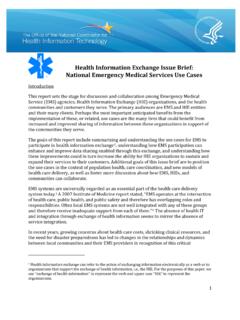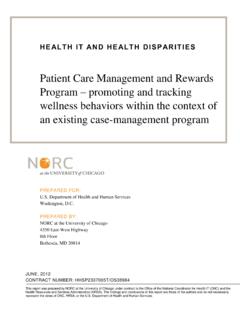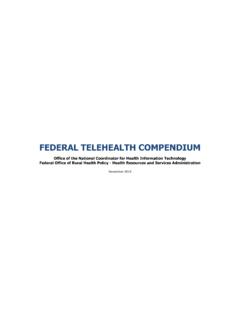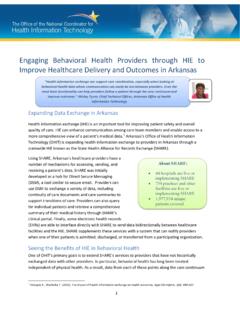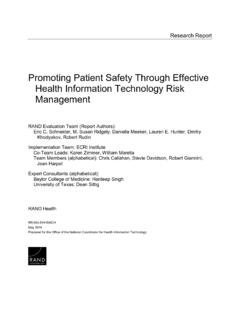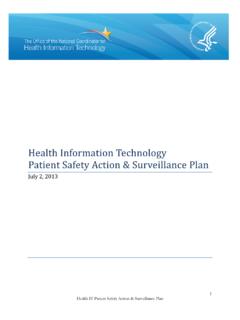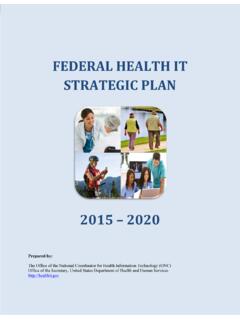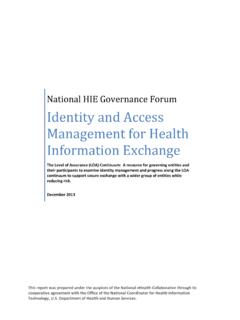Transcription of Improving Hospital Transitions and Care Coordination …
1 Improving Hospital Transitions and care Coordination using automated admission , discharge and Transfer Alerts A Learning Guide Presenting lessons learned by the 17 Beacon Community Awardees of the office of the national coordinator for health information technology in the Department of health and Human Services May 2013. The Beacon Community Cooperative Agreement Program demonstrates how health information technology ( health IT) investments and Meaningful Use of electronic health records (EHR). advance the vision of patient-centered care , while supporting better health , better care at lower cost. The Department of health and Human Services, office of the national coordinator for health IT (ONC) is providing $250 million over three years to 17 selected communities throughout the United States that have already made inroads in the development of secure, private, and accurate systems of EHR adoption and health information exchange.
2 Each of the 17. communities with its unique population and regional context is actively pursuing the following areas of focus: Building and strengthening the health IT infrastructure and exchange capabilities within communities, positioning each community to pursue a new level of sustainable health care quality and efficiency over the coming years;. Translating investments in health IT to measureable improvements in cost, quality, and population health ; and Developing innovative approaches to performance measurement, technology , and care delivery to accelerate evidence generation for new approaches. For more information about the Beacon Community Program visit This Learning Guide was developed by the Beacon Nation Project, funded by the Hawaii Island Beacon Community, an awardee of the ONC Beacon Community Program. The Beacon Nation project seeks to promote innovation in health IT by gathering and disseminating lessons learned from the 17.
3 Beacon Communities about building and strengthening health IT infrastructure, testing innovative approaches, and making strides toward better care , better health , and lower costs. For more information about the Beacon Nation project visit ii Acknowledgments The following individuals provided expert review, input, and advice on the development of this Learning Guide: Alex Alexander, MPA, MBA, Senior Project Manager, Center for the Science of health care Delivery, Mayo Clinic, Southeast Minnesota Beacon Community Alexander Baker, MPP, Project Officer, ONC Beacon Community Program, office of the national coordinator for health IT Jeff Black, Data Analyst, HealthInsight, Utah Beacon Community Steve Allen, Operations Director, HEALTHeLINK, Western New York Beacon Community Lisa Bielamowicz, MD, Executive Director and CMO, The Advisory Board Company Patricia Bondurant, DNP, MN, RN, Program Director, HealthBridge, Greater Cincinnati Beacon Collaboration Liam Bouchier, Senior Project Manager, Louisiana Public health Institute, Crescent City Beacon Community Hunt Blair, Principal Advisor, State HIT-enabled care Transformation, office of the national coordinator for health It Theodore Chan, MD, Co-Principal Investigator, University of California, San Diego.
4 San Diego Beacon Community Kim Chaundy, IT Program Director, Keystone Beacon Community Joyce Coutu, Rhode Island Beacon Community; Senior Associate, HIE Project Management, Rhode Island Quality Institute Nick Davis, PhD, Data Scientist, Tulsa Beacon Community Program, MyHealth Access Network Erica Galvez, MA, Community of Practice Director, State health information Exchange Program, office of the national coordinator for health IT. Anupam Goel, MD, MBA, Vice President, Clinical information , Advocate Healthcare Bob Hoover, Program Manager, Western New York Beacon Community Gary Kerl, Program Manager, HEALTHeLINK, Western New York Beacon Community Anjum Khurshid, PhD, MPAff, MBBS, Former Program Director, Crescent City Beacon Community; Director, health Services Division, Louisiana Public health Institute James Killeen, MD, Chief Technical Architect, University of California, San Diego, San Diego Beacon Community Janhavi Kirtane Fritz, MBA, Acting Director, ONC Beacon Community Program, office of the national coordinator for health IT.
5 Iii Irene Koch, Esq., Executive Director, Brooklyn health information Exchange Jonathan Leviss, MD, Chief Medical Officer, Rhode Island Quality Institute, Rhode Island Beacon Community Kristin Lyman JD, MHA, Associate Director, health Systems Division, Louisiana Public health Institute; Former Program Manager, Crescent City Beacon Community Nancy A. Maloney, MBA, Senior Business Architect, Western New York Beacon Community Trudi Matthews, Director of Policy and Public Relations, HealthBridge, Greater Cincinnati Beacon Collaboration Chris Muir, MPA, Program Manager, State health information Exchange Program, office of the national coordinator for health IT. Gaurav Nagrath, MBA, Lead Strategist, Crescent City Beacon Community; Chief information Officer, Louisiana Public health Institute Diane Parrish, RN, Clinical Implementation Specialist Quality Assurance Manager, Western New York Beacon Community Kerri Petrin, MPH, Project Officer, ONC Beacon Community Program, office of the national coordinator for health IT.
6 Rhonda Poirier, DrPH, Senior Advisor to the Deputy national coordinator for Policy & Programs, office of the national coordinator for health IT. Dan Porreca, Program Director, Executive Director, HEALTHeLINK, Western New York Beacon Community John Rancourt, MPA, Program Analyst, office of the national coordinator for health IT. Julie Schilz, BSN, MBA, Director, Primary care Strategies, WellPoint Barbara Sorondo, MD, Lead Evaluator, Eastern Maine Healthcare Systems, Bangor Beacon Community Lee Stevens, Director, State health information Exchange Policy, office of the national coordinator for health IT. Indu Subaiya, MD, MBA, Co-Chairman and CEO, health Micky Tripathi, PhD, MPP, President and CEO, Massachusetts eHealth Collaborative Chuck Tryon, MSKM, Chief of Program and Knowledge Management, Tulsa Beacon Community Program, MyHealth Access Network Jim Younkin, Program Director, Geisinger health Systems, Keystone Beacon Community iv Table of Contents Acknowledgments.
7 Iii Background .. 1. Beacon Communities .. 1. Setting the Stage for Success .. 4. Lessons from Beacon 5. Implementation Objective #1: Confirm that an ADT System Supports the Community's Goals .. 6. Implementation Objective #2: Establish Project Scope, Design and Implementation Plan .. 14. Implementation Objective #3 Evaluate the Ongoing Performance and Impact of ADT- based Alert System .. 22. Implementation Objective #4: Obtain ADT information and Transform into Clinically Meaningful Alerts .. 24. Implementation Objective #5: Integrate ADT-Based Alerts into care Provider Workflows .. 32. Looking Ahead .. 37. Appendices .. A-1. Appendix A: Implementation Objectives Summary ..A-1. Appendix B: Beacon Community Experience with ADT-Based Alerts Implementation ..A-4. Appendix C: Sample Data Use Agreement ..A-12. Appendix D: Potential Performance Metrics for ADT-Based Alert Programs ..A-15. Appendix E: Sample care Management Process Flow from the Greater Cincinnati Beacon Collaboration.
8 A-18. Appendix F: Acronyms and Key Definitions ..A-18. Appendix G: References ..A-22. v Table of Exhibits Exhibit 1: Foundational Elements for 4. Exhibit 2: Contributing Beacon 6. Exhibit 3: Implementation Objectives .. 6. Exhibit 4: Key Considerations by Stakeholder Group .. 7. Exhibit 6: Sample Systems Overview .. 15. Exhibit 7: Guiding Principles to Determine Whether a DUA Requires Amendment .. 16. Exhibit 8: The Plan-Do-Study-Act Cycle .. 19. Exhibit 9: Process by Which an ADT Message Is Transformed into an Alert .. 25. Exhibit 10: Challenging ADT-Based Alert System Message Fields .. 27. Exhibit 11: Training Recommendations for Technical Staff .. 34. Exhibit 12: ADT-based Alert Process Workflow .. 35. Exhibit A-1: Foundational Elements for Success ..A-1. Exhibit A-2: Implementation Objectives Summary and Action Steps ..A-2. Exhibit A-3: High Level Duration and Overlap of Implementation Work ..A-3. Exhibit B-1: Beacon Community ADT-Based Alerts Experience.
9 A-4. Exhibit F-1: Acronyms ..A-19. Exhibit F-2: Definitions ..A-21. vi Background The Affordable care Act (ACA) provides incentives to reduce Hospital readmission rates through accountable care organizations, shared savings programs, and penalties. These strategies promote improved care Coordination , especially at the point of discharge i, and encourage prevention of unnecessary utilization of Hospital services. As a result, payers, hospitals and primary care practices have a strong business case to focus on Improving care Transitions and reducing avoidable readmissions and Emergency Department (ED) visits. Reducing avoidable readmissions and Improving care Transitions continues to be challenging, despite increased national awareness through programs such as the Centers for Medicare and Medicaid Partnership for Patients. The Institute of Medicine report Crossing the Quality Chasm: A New health System for the 21st Century, identified health information technology ( health IT) as a means of supporting care management and Improving the quality of care .
10 Ii Communities have looked to health IT and health information exchange (HIE) systems for communication solutions to enhance and augment their care management and care Transitions improvement programs. One approach involves sending automatic notifications or alerts from hospitals to primary care practices and/or care managers when a patient has a Hospital admission , discharge or transfer. These notifications and alerts are designed to improve the timely flow of information so providers and case managers can quickly and effectively address the health care needs of their patients transitioning from inpatient facilities to community care . In addition to improved patient health status, these alerts and notifications are expected to facilitate a reduction in Hospital readmissions. iii Beacon Communities The health and Human Services (HHS) office of the national coordinator for health IT (ONC) provided $250. million over three years (2010 - 2013) to 17 selected Target Audience: This learning Beacon Communities throughout the United States that guide is designed for communities had already made inroads in using health IT as a that have a stated goal to reduce foundation for local improvement and innovation.
